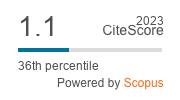Mosquito larvicidal bioassay with the fruit extracts of Diospyros kaki on filarial vector Culex quinquefasciatus
DOI:
https://doi.org/10.55779/nsb16211503Keywords:
bioactive compounds, Culex quinquefasciatus, Diospyros kaki, FT-IR, GC-MS, LC50 and LC90 valuesAbstract
Due to the emergence of resistance of the commonly used synthetic pesticide, vector control is in grave danger. Application of biocontrol agents may be a suitable alternative approach in vector control. The purpose of this study was to evaluate the larvicidal effectiveness of crude and methanolic fruit extracts of Diospyros kaki against Culex quinquefasciatus, the carrier of human filarial worm. The methanol extract showed promising result in biocontrol assay than crude extract. The methanolic extract had the LC50 and LC90 values of 46 ppm and 186 ppm, respectively against 1st instar larvae after 72 hours of exposure, The rate of mortality was positively associated with the solvent extracts in increasing concentrations, having a regression coefficient value near to 1 in each case, showing a definite positive dose-dependent mortality. During chemical characterization of the solvent extract by GC-MS and FT-IR studies, some bioactive compounds like 5,8,11,14,17-Eicosapentaenoic Acid, Methyl 4,7,10,13,16,19-Docosahexaenoate, cyclotrisiloxane hexamethyl and Arsenous acid, tris(trimethylsilyl) ester were identified that showed the larvicidal activity against mosquito larvae either singly or jointly. Thus, D. kaki fruit extract showed excellent potential as a bio control agent for Cx. quinquefasciatus and the isolated bioactive phytochemical may be utilized as a source of a powerful insecticide.
Metrics
References
Abbott WS (1925). A method of computing the effectiveness of an insecticide. Journal of Economic Entomology 18:265-266. http://dx.doi.org/10.1093/jee/18.2.265a
Anees AM (2008). Larvicidal activity of Ocimum sanctum Linn. (Labiatae) against Aedes aegypti (L.) and Culex quinquefasciatus (Say). Parasitology Research 103(6):1451-1453. http://dx.doi.org/10.1007/s00436-008-0991-7
Banerjee S, Singha S, Laskar S, Chandra G (2011). Efficacy of Limonia acidissima L. (Rutaceae) leaf extract on larval immatures of Culex quinquefasciatus Say 1823. Journal of Tropical Medicine 4:711-716. https://doi.org/10.1016/S1995-7645(11)60179-X
Brown D (1995). Encyclopedia of herbs ad their uses. Dorling Kindersley, London.
Burman S, Bhattacharya K, Mukherjee D, Chandra G (2018). Antibacterial efficacy of leaf extracts of Combretum album Pers. against some pathogenic bacteria. BMC Complementary and Alternative Medicine 18:1-18. https://doi.org/10.1186/s12906-018-2271-0
Campbell FL, Sullivan WW, Smith LN (1993). The relative toxicity of nicotine, nabasine, methylanaba sine and lupinine for Culicine mosquito larvae. Journal of Economic Entomology 26:505-509. http://dx.doi.org/10.1080/00221309.1983.9711494
Chatterjee SN, Chandra G (2000). Role of Anopheles subpictus as a primary vector of malaria in an area in India. Japanese Journal of Tropical Medicine and Hygiene 28:177‐181. http://dx.doi.org/10.2149/tmh1973.28.177
Chowdhury N, Bhattacharjee I, Laskar S, Chandra G (2007). Efficacy of Solanum villosum Mill. (Solanaceae: Solanales) as a biocontrol agent against fourth instar larvae of Culex quinquefasciatus Say. Turkish Journal of Zoology 31(4):365-370.
Collins FH, Paskewitz SM (1995). Malaria: current and future prospects for control. Annual Review of Entomology 40:195-219. http://dx.doi.org/10.1146/annurev.en.40.010195.001211
De SK, Chandra G (1994). Studies on the filariasis vector-Culex quinquefasciatus at Kanchrapara, West Bengal, India. Indian Journal of Medical Research 99:255‐258.
Duke JA, Ayensu ES (1985). Medicinal plants of China. Reference Publications, Inc.
Elango G, Rahuman AA, Bagavan A, Kamaraj C, Zahir AA, Venkatesan C (2009). Laboratory study on larvicidal activity of indigenous plant extracts against Anopheles subpictus and Culex tritaeniorhynchus. Parasitology Research 104(6):1381-1388. http://dx.doi.org/10.1007/s00436-009-1339-7
Finney DJ (1971). Probit analysis. Cambridge University Press: Cambridge XV, pp 333.
Ghosh A, Chowdhury N, Chandra G (2012). Plant extracts as potential mosquito larvicide. Indian Journal of Medical Research 135:581-598.
Harborne JB (1984). Phytochemical methods. 2nd ed. Chapman & Hall: London, pp 85-196.
Hossain E, Chandra G, Nandy AP, Mondal SC, Gupta JK (2012). Antihelminthic effect of a methanol extract of leaves of Bombax malabaricum on Paramphistomum explanatum. Parasitology Research 110(3):1097-1102. https://doi.org/10.1007/s00436-011-2594-y
Maheswaran R, Sathis S, Ignacimuthu S (2008). Larvicidal activity of Leucus aspera (Willd.) against the larvae of Culex quinquefasciatus Say and Aedes aegypti L. International Journal of Integrative Biology 2(3):214-217.
Peng Z, Yang J, Wang H, Simons FER (1999). Production and characterization of monoclonal antibodies to two new mosquitoes Aedes aegypti salivary proteins. Insect Biochemistry and Molecular Biology 29:909-914. http://dx.doi.org/10.1016/S0965-1748(99)00066-1
Prabakar K, Jebanesan A (2004). Larvicidal efficacy of some Cucurbitaceous plant leaf extracts against Culex quinquefasciatus (Say). Bioresource Technology 95:113-114. http://dx.doi.org/10.1016/j.biortech.2003.05.001
Rawani A., Mallick HK, Ghosh A, Chandra G (2009). Larvicidal activities of three plants against filarial vector Culex quinquefasciatus Say (Diptera: Culicidae). Parasitology Research 105:1411-1417. http://dx.doi.org/10.1007/s00436-009-1573-z
Singha S, Adhikari U, Chandra G (2011). Smoke repellency and mosquito larvicidal potentiality of Mesua ferra L. leaf extract against filarial vector Culex quinquefasciatus Say. Asian Pacific Journal of Tropical Biomedicine 1(1):119-123. https://doi.org/10.1016/S2221-1691(11)60137-8
Sofowora A (1993). Medicinal plants and medicine in Africa. Spectrum Books Ltd Ibadan, pp 150-153.
Suwannee P, Amara N, Maleeya K, Usavadee T (2006). Evaluations of larvicidal activity of medicinal plant extracts to Aedes aegypti (Diptera: Culicidae) and other effects on a non-target fish. Insect Science 13:179-188. https://doi.org/10.1111/j.1744-7917.2006.00080.x
World Health Organization (1992). Vector resistance to pesticides. Fifteenth report of the WHO Expert Committee on Vector Biology and Control. WHO Technical Report Series 818:1-62.
Youdeowei A, Service MW (1983). Pest and vector management in the tropics: With particular reference to insects, ticks, mites, and snails. The University of Wisconsin, Madison pp 399.
Downloads
Published
How to Cite
Issue
Section
License
Copyright (c) 2024 Koushik K. MANDAL, Manali DUTTA, Priyanka MANDAL, Goutam CHANDRA

This work is licensed under a Creative Commons Attribution 4.0 International License.
Papers published in Notulae Scientia Biologicae are Open-Access, distributed under the terms and conditions of the Creative Commons Attribution License.
© Articles by the authors; licensee SMTCT, Cluj-Napoca, Romania. The journal allows the author(s) to hold the copyright/to retain publishing rights without restriction.
License:
Open Access Journal - the journal offers free, immediate, and unrestricted access to peer-reviewed research and scholarly work, due SMTCT supports to increase the visibility, accessibility and reputation of the researchers, regardless of geography and their budgets. Users are allowed to read, download, copy, distribute, print, search, or link to the full texts of the articles, or use them for any other lawful purpose, without asking prior permission from the publisher or the author.














.png)















